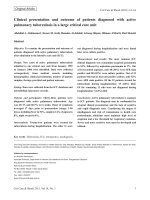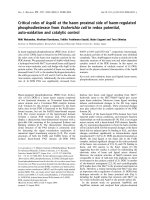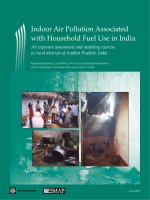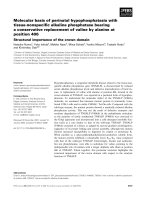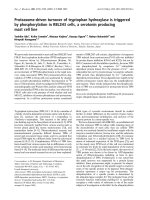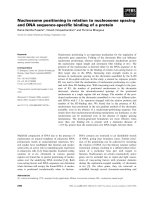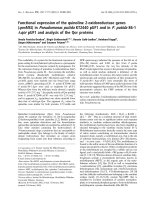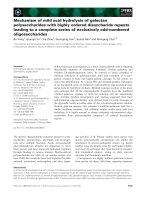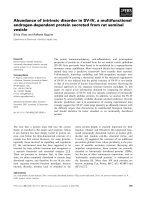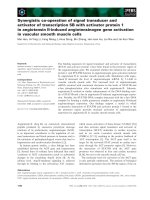Sibling relationships of female adolescents with nonsuicidal self-injury disorder in comparison to a clinical and a nonclinical control group
Bạn đang xem bản rút gọn của tài liệu. Xem và tải ngay bản đầy đủ của tài liệu tại đây (894.91 KB, 13 trang )
Tschan et al.
Child Adolesc Psychiatry Ment Health
(2019) 13:15
/>
Child and Adolescent Psychiatry
and Mental Health
RESEARCH ARTICLE
Open Access
Sibling relationships of female adolescents
with nonsuicidal self‑injury disorder
in comparison to a clinical and a nonclinical
control group
Taru Tschan1†, Janine Lüdtke2†, Marc Schmid2 and Tina In‑Albon1*
Abstract
Background: Adolescents’ nonsuicidal self-injury (NSSI) leads to distress that affects the whole family system, and
siblings are reported to suffer from disrupted family communication and functioning. So far, no studies have exam‑
ined the quality of relationships between adolescents with NSSI and their siblings. The aim of the present study was
to examine the sibling relationship quality of adolescents with NSSI, adolescents with other mental disorders without
NSSI (clinical controls, CC), and adolescents without current or past experience of mental disorders (nonclinical con‑
trols, NC).
Methods: 139 female adolescents aged 13–20 years (mean age = 16.18 years, SD = 1.62, NSSI: n = 56, CC: n = 33, NC:
n = 50) and 73 siblings aged 10–28 years (mean age = 16.88 years, SD = 4.02, 60.3% female) participated. Self-report
measures were used to assess psychopathology and sibling relationship quality.
Results: Siblings reported a wide range of negative emotional and familial consequences, such as feeling left alone
with their sister’s issues or a distressing family situation, as a result of their sister’s NSSI. Siblings of adolescents with
NSSI experienced significantly more coercion in the relationship with their sister compared to CC (d = 1.08) and NC
(d = 0.67) siblings, indicating an imbalance of dominance and control in their relationship. Further, adolescents with
NSSI reported significantly less warmth and empathy in the sibling relationship and higher rivalry scores between
their siblings and themselves than NC adolescents, suggesting higher levels of parental favoritism among parents
of adolescents with NSSI compared to NC parents (d = 0.93). Among siblings of adolescents with NSSI, high levels of
warmth, conflict, and empathy were significantly associated with internalizing problems. For adolescents with NSSI
a significant association was found between internalizing problems and coercion and externalizing problems and
similarity.
Conclusions: Given the negative impact of NSSI on siblings’ emotional well-being and family life, efforts should
be made to offer siblings psychoeducation and support to help them cope with the emotional and familial conse‑
quences of their sister’s NSSI. Given adequate support, siblings can in turn be a source of emotional support for their
sister.
Keywords: Nonsuicidal self-injury, Sibling relationship, Sibling agreement, Family
*Correspondence: in‑albon@uni‑landau.de
†
Taru Tschan and Janine Lüdtke contributed equally to the research
reported in this manuscript
1
Clinical Child and Adolescent Psychology, University of Koblenz-Landau,
Ostbahnstraße 12, 76829 Landau, Germany
Full list of author information is available at the end of the article
© The Author(s) 2019. This article is distributed under the terms of the Creative Commons Attribution 4.0 International License
( which permits unrestricted use, distribution, and reproduction in any medium,
provided you give appropriate credit to the original author(s) and the source, provide a link to the Creative Commons license,
and indicate if changes were made. The Creative Commons Public Domain Dedication waiver ( />publicdomain/zero/1.0/) applies to the data made available in this article, unless otherwise stated.
Tschan et al. Child Adolesc Psychiatry Ment Health
(2019) 13:15
Introduction
Nonsuicidal self-injury (NSSI) is a highly prevalent
behavior among adolescents and associated with various mental health problems and suicidality [1–3]. NSSI
is defined as the repetitive, deliberate, direct, and socially
unaccepted destruction or alteration of one’s own body
tissue without the intent to die [4]. Pooled international
lifetime prevalence rates among adolescents (including
single acts of NSSI) are around 17% [5], with 6.7% [6]
reporting repetitive NSSI according to DSM-5 criteria
[4]. Females are more likely to report a history of NSSI
than men, particularly in clinical samples [7].
Previous research has emphasized the role of maladaptive family functioning, such as emotional invalidation
and lack of family support, as crucial proximal risk factors for the development of NSSI [8–13]. Contrary, family support and positive family functioning were found
to predict the cessation of NSSI [10, 11, 14]. Similarly,
a review on psychosocial treatment for self-injurious
thoughts and behaviors concluded that a crucial part of
efficacious interventions is improving familial relationships [15]. However, research on familial relationships in
the context of adolescent NSSI has so far focused primarily on parent–child relationships, while remarkably little
is known about sibling relationship quality. The sibling
relationship is life’s longest lasting and one of the most
important relationships, as children spend more time
with their siblings than with their parents [16]. Sibling
relationships encompass positive (e.g., warmth, intimacy,
empathy) and negative (e.g., conflict, rivalry) features and
can have a major impact on sibling’s lives and wellbeing
(see [17] for a review). Social or observational learning
are mechanisms to describe generalization of negative
behaviors among siblings, such as hostile behavior [18].
A meta-analysis found that sibling warmth was significantly associated with less internalizing and externalizing problem behavior in children and adolescents
[16]. Within positive sibling relationships, children and
adolescents may learn favorable strategies to manage
and regulate their emotions, leading to a lower risk of
developing symptoms of depression, anxiety and aggression. On the contrary, sibling conflict was significantly
related to more internalizing and externalizing problems
[16]. Frequent fighting among siblings or observing a
siblings hostile behavior might lead to generalization of
negative behaviors to other contexts via social learning
mechanisms [18]. Noteworthy, the association between
internalizing and externalizing problems was stronger for
sibling conflict than sibling warmth.
Furthermore, there is some evidence that children
and adolescents with mental disorders have poorer
sibling relationships compared to nonclinical individuals. Sibling relationships of children with attention
Page 2 of 13
deficit hyperactivity disorder (ADHD) are characterized
by higher conflict but equal levels of warmth compared
to children without ADHD [19]. Noteworthy, the authors
suggest that comorbid internalizing and externalizing
symptoms might be more powerful predictors of sibling warmth and conflict than ADHD per se. Moreover,
poor sibling relationships in childhood and adolescence
were found to predict the occurrence of major depression 30 years later [20]. Surprisingly, most research on
sibling relationship quality and psychopathology include
low-risk community samples [16], while there is a lack
of research on sibling relationships of children and adolescents with clinically significant mental health issues
including NSSI [17].
Adolescent NSSI behavior appears to impact the whole
family system, leading to difficulties in parent–child relationships and disrupting family communication, family dynamics, and family functioning [21, 22]. Interview
studies of parents’ reactions to their children’s NSSI
behavior suggest that parents commonly have feelings
of distress, insecurity, anxiety, guilt, and helplessness
[21, 22]. Because parental time, energy, and attention is
focused on the child with self-injuring behavior, parents
express worries about an imbalance in parental involvement between siblings, particularly neglecting their
other children [22–25]. Adolescents’ NSSI behavior and
the distress it causes in the family likely affect siblings,
especially if they are of a similar age, as these siblings,
too, are trying to navigate through adolescence or young
adulthood [22]. According to parents, siblings’ reactions
to the NSSI behavior include a wide range of feelings
such as anger, resentment, frustration, stress, simultaneous empathy and irritation, responsibility, worries about
stigma at school, and often help and support [22]. Furthermore, some siblings have indicated feeling anxious
about triggering an episode of self-injury with their own
behavior [22]. To date, studies reporting data on siblings of adolescents with NSSI rely on parental reports,
while no studies exist that assess sibling self-report with
respect to their reactions to NSSI or sibling relationship
quality.
It has been well documented that interpersonal conflicts often serve as triggers for engaging in NSSI [12, 26].
Adolescents with NSSI frequently report negative peer
experiences such as peer victimization, which can significantly increase the risk of future NSSI [27]. Notably, the
source of victimization may also be in the family; a longitudinal study [28] suggested that sibling bullying in early
adolescence is significantly associated with NSSI behavior at age 18. Identifying risk factors for NSSI within
the family might help researchers and clinicians better
understand the familial mechanisms that are involved in
NSSI and enable them to develop treatment modalities
Tschan et al. Child Adolesc Psychiatry Ment Health
(2019) 13:15
that include the improvement of familial relationships
to save and improve the mental health of all family
members.
The aim of the current study was threefold. First, we
aimed to shed light on how siblings of female adolescents
with NSSI feel about and evaluate their sister’s NSSI.
Second, we wanted to investigate sibling relationship
quality rated separately by adolescents with NSSI and a
sibling. Previous research has indicated discrepant perspectives on family functioning and parenting behavior
between adolescents with NSSI and their parents, with
adolescents reporting poorer outcomes than parents
[12, 29, 30]. Thus, we further aimed to examine the concordance between adolescent and sibling self-reported
sibling relationship quality. Third, we wanted to explore
the association between sibling relationship quality and
psychopathology for adolescents with NSSI and their siblings, respectively. Specifically, we aimed to answer the
following questions:
1. How do siblings react to their sister’s NSSI?
2.Do adolescents with NSSI differ from adolescents
without NSSI (clinical and nonclinical controls) and
from their siblings with respect to sibling relationship
quality?
3.To what extent do adolescents and their siblings
agree in their reports of relationship quality?
4. Is the sibling relationship quality associated with psychopathology in the NSSI/CC group?
Methods
Participants
Adolescents
The study included 139 female adolescents, aged
13–20 years (M = 16.18 years, SD = 1.62) that were consecutively recruited from different inpatient child and
adolescent psychiatric units and schools in Switzerland
and Germany. The sample comprised of 56 adolescents
with NSSI disorder, 33 adolescents with other mental
disorders without NSSI (clinical controls, CC), and 50
adolescents without current or past experience of mental
disorders (nonclinical controls, NC). Participants were
similar with respect to age, Welch’s F (2, 74.24) = 0.52.
The most frequent mental disorders according to DSMIV-TR of the NSSI group were depressive disorders
(76%), anxiety disorders (48.2%), disruptive behavior disorders (22.2%), borderline personality disorder (18.5%),
and eating disorders (18.5%). The CC group most frequently reported anxiety disorders (51.5%) and depressive disorders (45.4%), followed by eating disorders
(24.2%) and disruptive behavior disorders (12.1%).
Page 3 of 13
Siblings
Seventy-three siblings aged 10–28 years (M = 16.88 years,
SD =
4.02; 60.3% female) participated in the study.
We included only one sibling per adolescent, mainly
the one closest in age. Overall, 27 brothers participated (NSSI = 12, CC = 1, NC = 14). Groups of siblings
(NSSI = 21, CC = 11, and NC = 41) were similar with
respect to age, Welch’s F(2, 20.79) = 0.72. A minority of
siblings in the NSSI group (14.3%; 2 sisters, 1 brother)
had had their own experiences with NSSI.
Measures
To examine the adolescents’ current or past DSM-IVTR diagnoses for Axis I disorders, we conducted a clinical structured interview. The Diagnostic Interview for
Mental Disorders in Children and Adolescents (KinderDIPS) [31] assesses the most frequent mental disorders
in childhood and adolescence. Questions for substance
use disorders were included from the adult DIPS [32].
The Kinder-DIPS has good validity and reliability for
Axis I disorders (child version, κ= 0.48–0.88) [33]. NSSI
disorder was assessed according to the DSM-5 research
criteria, with questions reformulated as criteria. Interrater reliability estimates for the diagnosis of NSSI were
very good (κ= 0.90). Before conducting the interviews all
interviewers received an intensive standardized training.
Adolescents were administered the Structured Clinical Interview for DSM-IV Axis II disorders (SCID-II)
[34], to assess for personality disorders. The SCID-II has
been found to be suitable for use among adolescents [35].
Interrater reliability for borderline personality disorder in
our sample was very good (κ= 1.00).
The Youth Self-Report (YSR) [36, 37] was used to assess
a broad range of psychopathology. Two second-order
scales reflecting internalizing and externalizing problems
and a total problem score can be calculated. Internal consistency in the present sample was α = 0.96 for the total
score, α = 0.85 for the internalizing score, and α = 0.80 for
the externalizing score.
The Sibling Questionnaire is a self-developed questionnaire, designed for siblings of adolescents with NSSI
and consisting of 166 items [38]. Questions with good
face validity were gathered and reviewed by experts.
The first part contains demographic questions and asks
when siblings first noticed their sister’s NSSI, and if
they were told about it, who told them. Further questions refer to the siblings’ suspicions about the reasons
for their sister’s self-injury (α = 0.84), questions about
the functions of NSSI were formulated on the basis of
the Functional Assessment of Self-Mutilation [39] and
the Modified Ottawa/Ulm Self-Injury inventory [40].
The second part assesses the siblings’ own experiences
Tschan et al. Child Adolesc Psychiatry Ment Health
(2019) 13:15
with NSSI. In the third part, siblings are asked about
their feelings (α = 0.76) and reactions (α = 0.63) when
their sister engages in NSSI. The fourth part assesses the
impact of NSSI on family dynamics (α = 0.82). Reasons
for NSSI, siblings reactions and the impact of NSSI on
family dynamics were assessed on a scale ranging from
1 (fully applies) to 5 (does not apply at all). For siblings
feelings, response choices ranged from 1 (never) to 5
(almost always). Internal consistencies refer to the present sample. So far, the questionnaire has not been further validated.
The Adult Sibling Relationship Questionnaire (ASRQ)
[41] measures qualitative features of the sibling relationship in young adulthood and consists of 81 items spread
over 14 subscales. The three higher order factors are
warmth/closeness, conflict, and rivalry. The warmth subscale consists of items measuring affection, companionship, intimacy, and admiration and the conflict subscale
includes quarreling and antagonism between siblings.
The rivalry subscale determines whether the parents
favor a child, but not which child is favored. All items
except rivalry are assessed on a 5-point Likert scale ranging from 1 (hardly at all) to 5 (extremely much). For the
rivalry subscale, response choices are 0 (neither of us is
favored), 1 (I am/my sibling is sometimes favored), and 2
(I am/my sibling is usually favored). The questionnaire
showed good internal consistency [41]. In the present
sample, internal consistency was α = 0.93 for warmth,
α = 0.83 for conflict, and α = 0.83 for rivalry.
The Brother–Sister Questionnaire (BSQ) [42] consists
of 35 items and is used to distinguish dysfunctional from
well-functioning sibling relationships. The BSQ measures
the four dimensions empathy (emotional connectedness, caring), boundary maintenance (respect for siblings’
physical and psychological space), similarity (common
interests and experiences), and coercion (power and control of one sibling over another). The questionnaire demonstrated good psychometric properties [42]. Internal
consistency in the present sample was α = 0.95 for empathy, α = 0.83 for boundary maintenance, α = 0.68 for similarity, and α = 0.52 for coercion.
Procedure
Participants from the NSSI and CC sample were
recruited from nine collaborating child and adolescent psychiatric inpatient clinics. The inpatient clinics
were instructed to inform the participants at admission
about the study and asked for their consent to participate. Participants from the HC sample were recruited in
different high schools. Prior to our visit in the schools,
teachers were given detailed information about the study
and handed out written informed consent forms, to be
signed by the parents of the students participating. After
Page 4 of 13
obtaining written informed consent from the adolescents
and caregivers, clinical interviews and self-report questionnaires were performed in the inpatient clinics for the
NSSI and CC sample and in a classroom after school for
the HC group. After data collection for the participants
was completed, they were given consent forms and questionnaires for their siblings in case they were willing to
participate in the study. Consent form and questionnaires
from the siblings were then returned via mail. All participants, adolescents, their siblings and parents, were
informed about the study and gave their written consent
in accordance with the Declaration of Helsinki. The local
ethics committee approved the study.
Data analyses
We used multivariate analysis of variance (MANOVA) to
investigate group differences in sibling relationship. Post
hoc tests were conducted to analyze pairwise comparisons. The Bonferroni correction was used to control for
multiple comparisons. Effect sizes (Cohen’s d) were calculated to further analyze significant group differences.
Pearson product-moment correlation coefficients were
calculated to evaluate sibling agreement and associations
between sibling relationship quality and psychopathology. To compare correlations of sibling agreement, the
coefficients were converted to z scores. In order to examine adolescent-sibling discrepancies, raw and standardized difference scores were calculated. The standardized
difference scores were calculated by subtracting the sibling’s standardized score from the youth’s standardized
score [43]. The magnitude of discrepancy between standardized scores was examined by calculating the mean of
the absolute value of the difference between standardized
scores. All analyses were performed using SPSS version
25. Significance levels were set at α = 0.05.
Results
Siblings’ reactions to their sister’s NSSI
Siblings suspected the following reasons for their sister’s self-injury: to change the emotional pain into something physical (60.0%), to relieve tension (57.1%), to deal
with frustration (45.0%), and to cope with uncomfortable memories (42.9%). About half of the siblings (57.1%)
noticed their sister’s NSSI and the majority (90.5%) were
concerned about the behavior. A large proportion (85.7%)
believed that their sister might attempt suicide and
reported being relieved that their sister was hospitalized.
The most common emotional reactions to NSSI were
feeling sad (76.2%), depressed (66.7%), desperate (57.1%),
helpless (57.1%), angry (33.4%), scared (19.1%), and guilty
(14.3%). Several siblings endorsed that they sympathized
with their sister (61.9%) and felt distressed due to NSSI
(42.9%).
Tschan et al. Child Adolesc Psychiatry Ment Health
(2019) 13:15
Page 5 of 13
From the perspective of many siblings, the sister’s
issues determined the whole family life (42.9%) and they
perceived the family situation as very distressing (42.9%).
Around a quarter thought that their parents had found a
good way to handle their sister’s NSSI (28.6%). Another
quarter (23.8%) reported that they did not get their parents’ attention as often as their sisters did and shared the
opinion that their parents did not dare to put limits on
their sister (23.8%). A third (33.3%) reported supporting
their sister by talking with them about NSSI. However,
they perceived the conversations as helpful for their sisters (28.6%), but stressful for themselves and indicated
that they would like to get help to better cope with their
sisters NSSI (28.6%). Many siblings endorsed that they
would never understand why their sister is engaging in
NSSI (38.1%) and a sizeable proportion felt left alone
with the sister’s issues (71.4%). Less than half of the siblings (38.1%) reported being reasonably involved in their
sister’s therapy. Those siblings without their own NSSI
experience (85.7%) provided several reasons why they did
not engage in NSSI (see Table 1). Siblings reported having fewer friends who engage in NSSI (14.3%) than their
sister reported for herself (47.6%). Siblings of adolescents
with NSSI who also engaged in NSSI (14.3%) were all
older siblings who indicated that they had started selfinjuring earlier than their sister.
(p < 0.01, d = 0.73) and more rivalry (p < 0.01, d = 1.05) in
the sibling relationship than NC adolescents. The higher
rivalry score indicates parental favoritism for one child by
parents of adolescents with NSSI. No difference between
groups (NSSI, CC, NC) was found for the ASRQ subscale conflict (see Table 2). Regarding the BSQ subscales
the three groups differed significantly on the subscales
empathy, similarity, and boundary maintenance. Post
hoc analysis showed that adolescents with NSSI reported
significantly less empathy (p < 0.01, d = 0.68) and similarity (p < 0.01, d = 0.78) than NC adolescents. Adolescents
with NSSI reached higher scores in boundary maintenance than NC adolescents (p < 0.05, d = 0.43), higher
scores reflect less concern with boundary maintenance.
As shown in Table 2, no group difference emerged for the
subscale coercion.
Sibling relationship quality
Group comparisons based on reports of adolescents
with NSSI
Comparisons between adolescents and siblings in the NSSI
group
Results of the MANOVA showed a significant group difference for the ASRQ subscales warmth, F(2, 134) = 7.42,
p <
0.01, and rivalry, F(2, 134)
= 14.27, p < 0.01. Bonferroni-corrected post hoc analysis revealed that adolescents with NSSI reported significantly less warmth
Table
1 Siblings of adolescents with NSSI and their
reasons for why they not engage in self-injurious behavior
(n = 18)
Reason
Number
of siblings
%
I have better strategies to deal with stress
9
42.9
I have learned to be thick skinned
9
42.9
I feel less burdened by the family situation
8
38.1
I can express and vent my anger
8
38.1
I have better peer relationships
7
33.4
My sister has experienced more bad things
6
28.6
My sister is too sensitive
5
23.8
I am better at solving problems with our parents
5
23.8
My sister feels more burdened by conflicts with our
parents
5
23.8
Group comparisons based on siblings’ reports
The only significant difference emerged on the BSQ subscale coercion, F(2, 65) = 4.43, p = 0.016, η2 = 0.12, with
post hoc analysis showing that siblings of adolescents
with NSSI reported significantly more coercion than
CC siblings (p < 0.05, d = 1.08) and NC siblings (p < 0.05,
d = 0.67); see Table 2. No significant differences were
found for the remaining BSQ subscales or any ASRQ
subscale.
Significant differences in reports on relationship quality
of adolescents with NSSI and their siblings emerged for
similarity, F(1, 68) = 6.3, p < 0.05, η2 = 0.09, and boundary maintenance, F(1, 68)
= 81.07, p < 0.01, η2 = 0.54,
with adolescents with NSSI reporting lower scores on the
similarity scale and higher scores on the boundary maintenance scale, indicating less concern with boundary
maintenance than their siblings.
Sibling agreement
The results of sibling agreement are displayed in Table 3.
The level of sibling agreement in the NSSI and NC group
was low, r = 0.05 to 0.35. Siblings of the CC group showed
a significant agreement regarding warmth (r = 0.74) and
similarity (r = 0.82). The agreement for both subscales
was significantly higher among siblings of the CC group
than among NSSI and NC siblings; see Table 3.
In addition to sibling agreement, Table 4 reflects sibling
discrepancies showing raw and standardized difference
scores as well as absolute value standardized differences.
There was considerable variability among the difference
scores, as indicated by large standard deviations of the
raw discrepancy. The mean of the absolute value of the
difference between standard scores indicates that the
Tschan et al. Child Adolesc Psychiatry Ment Health
(2019) 13:15
Page 6 of 13
Table 2 Means (and standard deviations) derived from the ASRQ and BSQ on sibling relationship quality and the YSR
on psychopathological symptoms
Measure
Adolescents
Siblings
NSSI (n = 56) M (SD) CC (n = 33)
M (SD)
NC (n = 50)
M (SD)
F(2, 134) η
2
NSSI (n = 21)
M (SD)
CC (n = 11)
M (SD)
NC (n = 41)
M (SD)
F(2, 65)
M (SD)
η2
ASRQ
Warmth
141.27 (38.12)
7.42**
0.10 155.62 (21.72) 159.15 (31.88) 154.00 (28.50) 0.14
0.00
Conflict
57.81 (14.49)
152.75 (26.82) 164.97 (25.69)
57.88 (14.46)
56.64 (13.20)
0.12
0.00
56.11 (13.36)
51.78 (9.51)
0.01
Rivalry
0.53 (0.47)
0.38 (0.41)
0.14 (0.23)
14.27**
0.18
0.26 (0.47)
0.10 (0.20)
55.28 (14.20) 0.33
0.31 (0.44)
0.91
0.03
BSQ
Empathy
3.12 (0.99)
3.39 (0.88)
3.70 (0.70)
5.39**
0.08
3.36 (0.56)
3.44 (0.70)
3.36 (0.67)
0.06
0.00
Boundaries
4.23 (0.71)
4.20 (0.67)
3.89 (0.88)
3.47*
0.05
2.25 (0.86)
1.89 (0.68)
2.06 (0.59)
0.96
0.03
Similarity
2.41 (0.67)
2.55 (0.46)
2.87 (0.50)
9.29**
0.12
2.78 (0.42)
2.57 (0.39)
2.61 (0.57)
0.83
0.03
Coercion
1.95 (0.68)
1.75 (0.68)
1.71 (0.63)
1.11
0.02
2.11 (0.59)
1.57 (0.19)
1.75 (0.52)
4.43*
0.12
YSR
INT
35.33 (10.14)
21.70 (9.29)
8.95 (5.87)
120.76**
0.64
10.13 (7.49)
9.04 (6.84)
10.53 (7.92)
0.14
0.00
EXT
19.94 (10.54)
11.61 (6.43)
9.33 (5.39)
23.42**
0.26
9.18 (5.03)
7.60 (5.14)
9.18 (5.03)
0.73
0.02
NSSI adolescents with nonsuicidal self-injury, CC clinical control group, NC nonclinical control group, ASRQ Adult Sibling Relationship Questionnaire, BSQ Brother Sister
Questionnaire, YSR Youth Self Report, INT Internalizing symptoms, EXT externalizing symptoms
* p < 0.05
** p < 0.01
Table 3 Sibling agreement on dimensions of relationship quality (Pearson correlations)
Measure
NSSI
(n = 42)
CC
n = 22 (n = 22)
NC
n = 82 (n = 82)
z scores
NSSI vs. CC
NSSI vs. NC
CC vs. NC
ASRQ
Warmth
0.07
0.74*
0.19
Conflict
0.13
0.52
0.31
Rivalry
0.11
− 0.03
0.08
BSQ
Empathy
0.12
0.42
0.31
Boundaries
0.20
0.58
0.06
Similarity
0.35
0.82*
0.25
Coercion
0.05
0.29
− 0.24
− 2.07*
− 0.43
− 1.05
− 0.66
− 0.77
− 0.70
0.33
− 1.08
− 1.86*
− 0.56
0.11
0.50
1.95*
0.66
− 0.28
0.33
1.55
0.39
2.32*
1.03
1.40
NSSI adolescents with nonsuicidal self-injury, CC clinical control group, NC nonclinical control group, ASRQ Adult Sibling Relationship Questionnaire, BSQ Brother–
Sister Questionnaire
* p < 0.05
** p < 0.01
difference between adolescent and sibling reports in the
CC and NC group was small for most aspects of relationship quality with less than one standard deviation (< 1).
The NSSI group showed the largest discrepancies (> 1 for
most subscales).
Association between sibling relationship quality
and psychopathology in the NSSI and CC group
Correlations between sibling relationship quality and psychopathology are presented separately for adolescents
with NSSI and their siblings in Tables 5 and 6. Among
adolescents with NSSI a significant association was found
between internalizing problems and coercion as well as
externalizing problems and similarity (both r = 0.27).
For adolescents in the CC group significant associations
emerged between internalizing problems and conflict
(r = 0.35) and boundary maintenance (r = − 0.47) as well
as externalizing problems and conflict (r = 0.47), similarity (r = 0.37) and coercion (r = 0.35). In the NSSI group
siblings’ reports showed that internalizing problems were
significantly associated with warmth, conflict, and empathy (all r = 0.48) in the sibling relationship. No associations
between sibling relationship quality and psychopathology
were found in reports of siblings in the CC group. Siblings
Tschan et al. Child Adolesc Psychiatry Ment Health
(2019) 13:15
Page 7 of 13
Table 4 Raw, standardized and absolute value standardized differences scores for adolescent and sibling reports
of sibling relationship quality
Measure
Difference scores
Raw M (SD)
NSSI
(n = 42)
Standardized M (SD)
CC
(n = 22)
NC
(n = 82)
NSSI
(n = 42)
CC
(n = 22)
Absolute Value Standardized M
(SD)
NC
(n = 82)
NSSI
(n = 42)
CC
(n = 22)
NC
(n = 82)
ASRQ
Warmth
3.11 (37.52)
Conflict
− 1.79 (19.90)
Rivalry
0.27 (0.48)
− 6.08 (23.15)
5.20 (11.68)
0.20 (0.42)
BSQ
9.50 (34.40) − 0.08 (1.36)
1.88 (15.68) − 0.28 (1.52)
− 0.16 (0.49)
0.51 (1.15)
− 0.22 (1.25)
Empathy
0.36 (0.96)
0.12 (0.86)
0.30 (0.81)
0.11 (1.37)
1.88 (1.23)
2.24 (0.73)
1.84 (0.95)
− 0.16 (1.70)
Similarity
− 0.08 (0.64)
− 0.25 (1.05)
0.07 (0.32)
0.21 (0.64)
0.07 (0.32)
− 0.05 (0.83)
0.25 (0.89)
0.76 (1.36)
Boundaries
Coercion
− 0.41 (0.84)
− 0.27 (1.18)
− 0.38 (1.82)
0.40 (0.99)
− 0.02 (0.60)
0.32 (0.54)
0.16 (1.24)
1.09 (0.76)
0.74 (0.54)
0.86 (0.90)
− 0.00 (1.20)
1.11 (1.04)
0.74 (0.48)
0.92 (0.76)
1.15 (0.99)
0.75 (0.97)
0.87 (0.90)
− 0.40 (1.17)
0.04 (1.18)
1.11 (0.76)
0.89 (0.85)
0.76 (0.90)
− 0.15 (1.28)
1.32 (1.03)
0.81 (0.63)
0.98 (0.83)
0.26 (1.17)
0.93 (0.76)
0.50 (0.28)
0.91 (0.76)
0.08 (1.48)
1.37 (1.23)
0.49 (0.36)
1.11 (0.95)
NSSI adolescents with nonsuicidal self-injury, CC clinical control group, NC nonclinical control group, ASRQ Adult Sibling Relationship Questionnaire, BSQ Brother–
Sister Questionnaire
Table 5 Pearson correlations of sibling relationship quality (ASRQ, BSQ) and psychopathological symptoms (YSR)
reported by adolescents with nonsuicidal self-injury disorder
Measure
1
2
3
4
5
6
7
8
ASRQ
1. Warmth
–
2. Conflict
− 0.54**
–
− 0.33*
0.15
–
4. Empathy
0.88**
0.03
− 0.61**
− 0.30*
–
5. Boundaries
6. Similarity
0.62**
7. Coercion
− 0.42**
− 0.31*
− 0.35*
3. Rivalry
BSQ
YSR
8. Internalizing problems
9. Externalizing problems
− 0.03
0.11
− 0.09
0.20
–
0.63**
0.16
–
0.23
− 0.50**
− 0.22
− 0.17
–
0.11
0.13
− 0.04
0.27*
–
0.22
− 0.01
0.11
0.02
0.18
0.38**
− 0.36**
0.50**
0.19
0.15
0.27*
ASRQ Adult Sibling Relationship Questionnaire, BSQ Brother–Sister Questionnaire, YSR Youth Self-Report
* p < 0.05
** p < 0.01
of the three groups did not differ significantly regarding
internalizing, F(2, 65) = 0.14, p > 0.05, or externalizing, F(2,
65) = 0.73, p > 0.05, problems.
Discussion
This study is the first to address siblings’ reactions to a
sister’s NSSI as well as aspects of sibling relationship
quality, such as warmth, rivalry, coercion, and conflict,
group differences (adolescents with NSSI, CC, NC)
with respect to sibling relationship quality, agreement
between adolescents with NSSI, CC, and NC and their
siblings, and the association between sibling relationship
quality and psychopathology separately for adolescents
with NSSI and their siblings.
Consistent with previous research on parental reports
of siblings’ emotional reactions to NSSI [21, 22], siblings
involved in this study described their sister’s NSSI as
being a source of distress, sadness, desperation, helplessness, and anger. The majority of siblings was concerned
about their sister’s NSSI as well as potential future suicidal behavior and felt relieved about their sister receiving inpatient psychiatric treatment. A third of siblings
supported their sister by talking to her about NSSI and
although they considered these conversations helpful for
their sister, they perceived them as distressing for themselves and wished for help to cope better with NSSI. In
fact, 71.4% of siblings felt left alone with the sister’s issues
and 38.1% will never understood why their sister was
Tschan et al. Child Adolesc Psychiatry Ment Health
(2019) 13:15
Page 8 of 13
Table 6 Pearson correlations of sibling relationship quality (ASRQ, BSQ) and psychopathological symptoms (YSR)
reported by siblings of adolescents with nonsuicidal self-injury disorder
Measure
1
2
3
4
5
6
7
8
ASRQ
1. Warmth
–
2. Conflict
0.02
–
3. Rivalry
− 0.33
0.06
BSQ
–
4. Empathy
0.72**
0.08
5. Boundaries
− 0.20
0.54*
0.20
0.19
–
− 0.04
0.15
0.19
–
0.12
0.76**
0.01
6. Similarity
0.12
0.07
7. Coercion
− 0.20
0.60**
YSR
8. Internalizing problems
0.48*
0.48*
9. Externalizing problems
0.32
0.13
− 0.11
0.11
− 0.01
− 0.29
–
0.48*
0.35
0.28
0.02
− 0.13
0.33
–
0.18
–
0.02
0.37
ASRQ Adult Sibling Relationship Questionnaire, BSQ Brother–Sister Questionnaire, YSR Youth Self-Report
* p < 0.05
** p < 0.01
engaging in NSSI. These findings highlight the need to
provide sufficient psychoeducation for family members to
increase their understanding of the behavior and enhance
the family’s communication and coping skills [44]. Relatives of individuals with a mental disorder have been
shown to benefit from psychoeducational support groups
[45, 46]. Based on the siblings’ reports in our study, NSSI
has a negative impact on emotional well-being and family
life, which raises the question of whether these siblings
might be at risk of developing their own mental health
issues. Research on siblings of individuals with mental
disorders has reported high levels of emotional distress,
especially if the sibling is still living with the family [47].
However, we found no group differences between siblings in the three groups with respect to internalizing or
externalizing symptoms. Nonetheless, given the reported
emotional impact of NSSI, the feeling of being left alone
with their sister’s issues, and the wish for support, it is
crucial to create opportunities for siblings to address
their worries about NSSI and to receive support. Due
to their extensive contact during childhood and adolescence, siblings are often key family members and can be a
great source of emotional and practical support [48, 49].
Siblings can help promote the well-being and recovery of
a sibling with a mental disorder, through engaging jointly
in appropriate activities, for example, exercise or sports,
or integrating the sibling in their social circle [50].
Adolescents with NSSI reported significantly less
warmth, empathy, and similarity and more rivalry in the
sibling relationship than NC adolescents. Furthermore,
they indicated significantly less concern with boundary
maintenance compared to NC adolescents. Adolescents
with NSSI felt less emotionally connected with their sibling and reported lower empathy, caring, intimacy, similarity, and companionship in their sibling relationship
compared to NC adolescents. There is some research
indicating that children and adolescents might have
similar experiences with siblings and peers in terms of
relationship quality [51–53]. A study by Pike and AtzabePoria [51] found that sibling affection predicted greater
positivity in their best friendships, while greater sibling hostility was related to lower positivity and greater
conflict with friends. Similarly, among children, sibling
warmth was positively associated with best friendship
quality, whereas sibling conflict was negatively associated with friendship quality [53]. A poorer relationship
quality with their siblings might be associated with the
peer problems of adolescents with NSSI [26, 54]. Adolescents with NSSI report significantly less perceived social
support from friends and family as well as having fewer
people to seek advice from than healthy controls, which
supports the notion that they experience difficulties with
forming relationships and developing adaptive interpersonal skills [26]. In order to deal with these negative emotional states emerging from stressful peer experiences,
NSSI may be used as a coping mechanism [55].
Adolescents with NSSI reported significantly higher
rivalry scores than NC adolescents, suggesting that
parents of adolescents with NSSI favor one child over
another more than NC parents do. The rivalry subscale
comprises items assessing maternal and paternal favoritism. This finding can be interpreted in light of research
emphasizing that the self-injuring child becomes the
center of familial attention, leading to an imbalance in
Tschan et al. Child Adolesc Psychiatry Ment Health
(2019) 13:15
parental involvement between siblings [22–25]. Similarly,
almost a quarter of siblings of adolescents with NSSI represented in this study experienced less parental attention
compared to their sister and believed that their parents
were having difficulties setting boundaries. Furthermore,
a considerable proportion of siblings endorsed the suggestion that the sister’s issues determined family life
for the whole family (42.9%). However, no group differences on the rivalry subscale between siblings emerged,
indicating no group differences with respect to parental
favoritism from the sibling’s point of view. Differential
parental treatment can have a negative impact on family dynamics and sibling relationships and is associated
with greater sibling conflict, antagonism, and controlling
behaviors [56–58]. The parental favoritism reported in
families of adolescents with NSSI might contribute to the
maladaptive family functioning, which has been found
to contribute to maintaining NSSI [11, 13]. Adolescents
with NSSI have significantly greater success in having
their boundaries respected by their siblings compared
to NC siblings, which might be linked to our finding that
the siblings of adolescents with NSSI reported significantly more coercion than both CC and NC adolescents.
As adolescents with NSSI showed more dominance and
control over their siblings, it might be easier for them to
maintain their boundaries.
Siblings of adolescents with NSSI scored significantly
higher on the coercion subscale compared to CC and
NC siblings, emphasizing the dominance and control of
adolescents with NSSI in their sibling relationship. Studies have shown that high levels of psychological control
from a sibling is associated with ill-being, adjustment
problems, and anxiety and depressive symptoms in the
victimized sibling [59–61]. However, coercion was not
associated with internalizing and externalizing problems
in siblings of adolescents with NSSI. As no clinical cut-off
score for the coercion scale exists, it is difficult to determine whether coercion levels in the sibling relationship
of adolescents with NSSI are abnormal or not. However,
as siblings in the NSSI group scored higher than both CC
and NC siblings, this issue requires further elaboration in
future studies.
Our results showed that siblings of adolescents with
NSSI involved in this study scored significantly lower
on the boundary maintenance scale of the BSQ than
their sisters, reflecting difficulties in establishing and
respecting firm and reasonable interpersonal boundaries between siblings [42]. Lower scores indicate that the
siblings fail to have their boundaries respected by their
sisters with NSSI. Furthermore, adolescents with NSSI
scored significantly lower on the similarity subscale than
their siblings, indicating that they see themselves as more
de-identified and different from their siblings and having
Page 9 of 13
less in common compared to their siblings rating. Previous research has shown that NSSI is associated with
identity confusion [62] and may provide a source of selfidentification [63]. Considering this, it is not surprising
that adolescents with NSSI don’t identify themselves with
their siblings but see themselves as different.
Overall, sibling agreement in the NSSI group was low,
indicating somewhat diverging perceptions of all relationship quality dimensions used in this study. This result
differs from an earlier study that found a substantial sibling agreement for the ASRQ subscales warmth, conflict,
and rivalry [64]. However, the average age of participants
(20.60 years) and siblings (23.00 years) was higher than
the average age of participants (16.18 years) and siblings
(16.88) in this study. Although adolescent and sibling
reports in this study differed for most aspects of sibling
relationship quality, the magnitude of these discrepancies was quite small, as measured by standardized scores.
Adolescents in the CC group showed the best sibling
agreement, especially on the subscales warmth and similarity. This result might be explained by differences in the
group sizes and should be further examined with larger
CC samples.
Dimensions of sibling relationship quality were only
moderately associated with psychopathological symptoms among both adolescents with NSSI and their
siblings. Among adolescents with NSSI externalizing
problems were significantly associated with similarity in
the sibling relationship, whereas internalizing problems
were significantly associated with coercion.
The first mentioned association can be interpreted
in line with previous research showing that high levels of intimacy (as a proxy for similarity) among siblings close in age might increase the affective intensity
of their conflicts [65, 66], thereby leading to higher levels of aggression. Coercion in sibling relationships can
be seen as important learning experience, since siblings
influence each other’s aversive and aggressive behavior,
e.g., through reinforcement [67]. However, behavioral
changes resulting from hostile sibling interactions can
cause internalizing symptoms [68].
Among siblings of adolescents with NSSI internalizing problems were significantly associated with conflict,
warmth, and empathy. The association between conflict
and internalizing problems is consistent with previous
research showing that greater sibling conflict during
childhood and adolescence leads to higher internalizing
symptoms [16], especially when siblings are close in age
[57]. The association between high levels of warmth and
empathy and internalizing problems may indicate that in
close sibling relationships, the sisters mental health issues
and NSSI might lead to worries and a negative emotional
impact on their sibling, resulting in elevated levels of
Tschan et al. Child Adolesc Psychiatry Ment Health
(2019) 13:15
internalizing symptoms. For adolescent friendships, corumination, excessive discussion of interpersonal problems, and negative feelings were found to be associated
with high-quality friendships but also with greater internalizing symptoms [69]. This may also count for close
siblings of adolescents with NSSI, who spend much time
discussing their sister’s problems.
In light of our finding that the relationship between
adolescents with NSSI and their siblings is characterized
by less warmth, empathy, and similarity and more coercion than in the NC group, and the well established link
between poor sibling relationship quality and emotional
and behavioral problems, indicates that sibling interventions (in terms of increasing warmth and reducing conflict) might be beneficial in reducing psychopathological
symptoms, for a review see Dirks et al. [17]. However,
promoting more engaged and positive sibling relationships may in turn yield the danger of increasing the emotional distress of the sibling, as outlined above. A review
on susceptibility to environmental influences highlights
that some characteristics such as genetic or temperament
factors may leave an individual more resistant or prone to
both negative and positive environmental influences [70].
Thus, some children and adolescents might perceive negative sibling experiences as more distressing than others,
or might be more likely to benefit from promoting positive sibling interactions [17]. Future research is necessary
to determine the circumstances in which incorporating
treatment components targeting sibling relationships or
family dynamics may be beneficial for improving psychological symptoms [17].
Despite the fact that sibling conflicts and aggression
can have severe negative consequences for children’s
and adolescent’s well-being, we only have a very limited
understanding of evidence-based programs promoting
positive sibling relationships. Preliminary evidence for
the improvement of sibling relationship quality among
school-aged children has been found for interventions
targeting children’s social skills (for a review see [71]).
These interventions either directly improve social skills in
sibling interactions via trained professionals or indirectly
by focusing on training parents on mediation skills. However, more research is needed with respect to interventions preventing or intervening with sibling conflict and
aggression.
The results of the present study should be interpreted
in the context of the following limitations. The sample
consisted of female adolescents admitted to an inpatient child and adolescent psychiatric unit and thus may
not generalize to other samples or to male adolescents.
The design of the study was cross-sectional. Therefore,
the current study cannot explain the direction of effects
between an adolescent’s NSSI and sibling relationship
Page 10 of 13
quality and family dynamics. This should be investigated
in future prospective longitudinal studies and on the
basis of a larger sample size, including male and female
adolescents. Boys who self-injure are a quite understudied population. The literature indicates that boys and
girls differ with respect to basic NSSI characteristics such
as methods, location, and functions, supporting the idea
that interventions should be gender-specific. Given that
male-preferred methods of NSSI include hitting and
burning, the nature of the behavior might be perceived
as aggressive rather than self-injurious, thereby masking
the true intention [72]. In light of these differences, it is
possible that NSSI performed by boys might elicit a different response from parents and siblings compared to
a self-injuring girl, however future studies on this matter are needed. To date, there is not sufficient data to
answer the question whether brothers might have a different coping of their sisters NSSI than a female sibling.
Studies in children and adolescents suggest that gender
composition and age difference of sibling pairs have a
moderating effect on sibling relationship quality, which in
turn might influence how siblings cope with maladjustment [16]. Thus, it is possible that a brother copes differently with his sisters NSSI than with a brothers NSSI and
vice versa. Further, adolescents with NSSI may perceive
their sibling relationship as less warm and supportive due
to a negative cognitive bias, this should be addressed in
future studies. More research into rivalry is needed in
order to understand, which child is favored by parents of
adolescents with NSSI and to investigate sibling rivalry,
since this study only considered parental rivalry. Another,
unavoidable limitation was the use of a non-validated
questionnaire for the assessment of sibling relationship
quality. Nevertheless, we addressed a neglected research
question. Strengths of the study were the use of the DSM5 diagnostic research criteria for NSSI and the use of a
multi-informant approach, including adolescent and
sibling reports as well as the inclusion of a clinical and a
nonclinical control group.
Conclusions
Adolescents with NSSI differed significantly with respect
to many dimensions of sibling relationship quality compared to the non-clinical controls (NC), but not compared to the clinical controls (CC). We found that the CC
group did not differ from adolescents with NSSI nor to
the NC group, indicating that differences between the
NSSI and the NC group may be attributed to a characteristic of the NSSI group. However, more research is
required to explore this relationship in further detail. We
found significant differences between all three groups
regarding the BSQ subscale coercion, emphasizing the
dominance, and control of adolescents with NSSI in
Tschan et al. Child Adolesc Psychiatry Ment Health
(2019) 13:15
their sibling relationship compared to both the CC and
NC group. Similarly, our results indicate that siblings fail
to have their boundaries respected by their sisters with
NSSI. Despite the fact that we found differences only
between adolescents with NSSI and NC, significant differences between all three groups were found among siblings, indicating a NSSI-specific association. Since this
manuscript aims to highlight the impact of NSSI on siblings and the siblings’ view on sibling relationship quality,
we believe that this manuscript adds important findings
to the literature.
According to the siblings represented in our study,
NSSI is associated with poor emotional well-being and
family life, as the family attention frequently centers
on concerns related to the sister’s mental health issues.
These results underline the importance of a sibling support component for siblings of adolescents with NSSI to
help them cope with the emotional and familial consequences of their sister’s NSSI and to prevent and reduce
any negative emotional impact in the long term.
Abbreviations
NSSI: nonsuicidal self-injury; CC: clinical controls; NC: nonclinical controls;
ASRQ: Adult Sibling Relationship Questionnaire; BSQ: Brother–Sister Question‑
naire; DSM: Diagnostic and Statistical Manual of Mental Disorders; Kinder-DIPS:
Diagnostic Interview for Mental Disorders in Children and Adolescents; SCID-II:
Structured Clinical Interview for DSM-IV Axis II disorders; YSR: Youth SelfReport; MANOVA: multivariate analysis of variance.
Authors’ contributions
TT and JL completed the data analyses and made substantial contributions to
the interpretation of the data and the drafting and revision of the manuscript.
TI and MS contributed to the ideas, the acquisition and interpretation of the
data, and the drafting and revision of the manuscript. All authors read and
approved the final manuscript.
Author details
1
Clinical Child and Adolescent Psychology, University of Koblenz-Landau,
Ostbahnstraße 12, 76829 Landau, Germany. 2 Department of Child and Ado‑
lescent Psychiatry, University of Basel, 4056 Basel, Switzerland.
Acknowledgements
We thank the participants in this study as well as the research assistants and
graduate students on the project at the University of Basel for their assistance
in data collection and management. The authors thank the following clinics
for recruitment: Zentrum für Kinder- und Jugendpsychiatrie und -psycho‑
therapie Clienia Littenheid AG, Kinder- und Jugendpsychiatrischer Dienst
Koenigsfelden, Kinder- und Jugendpsychiatrie Kriens, St. Elisabethen-Kranken‑
haus Kinder- und Jugendpsychiatrie Loerrach, Kinder- und Jugendpsychiatrie
Chur, Universitaere Psychiatrische Kliniken Kinder- und Jugendpsychiatrie
Basel, Universitaetsklinik fuer Kinder- und Jugendpsychiatrie Bern, Kinder- und
Jugendpsychiatrische Klinik Solothurn, and Klinik Sonnenhof Kinder- und
Jugendpsychiatrisches Zentrum Ganterschwil.
Competing interests
The authors declare that they have no competing interests.
Availability of data and materials
The data sets analyzed during the current study are available from the cor‑
responding author on reasonable request.
Page 11 of 13
Consent for publication
All participants and parents gave their written consent.
Ethics approval and consent to participate
The local ethics committee (Ethikkommission Beider Basel, EKBB) approved
the study.
Funding
This study is supported by grant project 100014_135205 awarded to Tina
In-Albon in collaboration with Marc Schmid by the Swiss National Science
Foundation.
Publisher’s Note
Springer Nature remains neutral with regard to jurisdictional claims in pub‑
lished maps and institutional affiliations.
Received: 28 August 2018 Accepted: 28 February 2019
References
1. Hamza CA, Willoughby T. Nonsuicidal self-injury and suicidal risk among
emerging adults. J Adolesc Health. 2016;59:411–5.
2. In-Albon T, Ruf C, Schmid M. Proposed diagnostic criteria for the DSM-5
of nonsuicidal self-injury in female adolescents: diagnostic and clinical
correlates. Psychiatry J. 2013;2013:12. https://doi.org/10.1155/2013/15920
8.
3. Wilkinson PO, Qiu T, Neufeld S, Jones PB, Goodyer IM. Sporadic and
recurrent non-suicidal self-injury before age 14 and incident onset of psy‑
chiatric disorders by 17 years: prospective cohort study. Br J Psychiatry.
2018;212:222–6.
4. American Psychiatric Association. Diagnostic and statistical manual of
mental disorders (DSM-5®). Philadelphia: American Psychiatric Pub; 2013.
5. Swannell SV, Martin GE, Page A, Hasking P, John NJS. Prevalence of
nonsuicidal self-injury in nonclinical samples: systematic review, metaanalysis and meta-regression. Suicide Life Threat Behav. 2014;44:273–303.
6. Zetterqvist M, Lundh L-G, Dahlström Ö, Svedin CG. Prevalence and
function of non-suicidal self-injury (NSSI) in a community sample of
adolescents, using suggested DSM-5 criteria for a potential NSSI disorder.
J Abnorm Child Psychol. 2013;41:759–73.
7. Bresin K, Schoenleber M. Gender differences in the prevalence of nonsui‑
cidal self-injury: a meta-analysis. Clin Psychol Rev. 2015;38:55–64.
8. Baetens I, Andrews T, Claes L, Martin G. The association between family
functioning and NSSI in adolescence: the mediating role of depressive
symptoms. Fam Sci. 2015;6:330–7.
9. Brausch AM, Gutierrez PM. Differences in non-suicidal self-injury and
suicide attempts in adolescents. J Youth Adolesc. 2010;39:233–42.
10. Cassels M, van Harmelen A-L, Neufeld S, Goodyer I, Jones PB, Wilkinson P.
Poor family functioning mediates the link between childhood adversity
and adolescent nonsuicidal self-injury. J Child Psychol Psychiatry.
2018;59:881–7.
11. Tatnell R, Kelada L, Hasking P, Martin G. Longitudinal analysis of adoles‑
cent NSSI: the role of intrapersonal and interpersonal factors. J Abnorm
Child Psychol. 2014;42:885–96.
12. Tschan T, Schmid M, In-Albon T. Parenting behavior in families of female
adolescents with nonsuicidal self-injury in comparison to a clinical
and a nonclinical control group. Child Adolesc Psychiatry Ment Health.
2015;9:17.
13. You J, Leung F. The role of depressive symptoms, family invalidation and
behavioral impulsivity in the occurrence and repetition of non-suicidal
self-injury in Chinese adolescents: a 2-year follow-up study. J Adolesc.
2012;35:389–95.
14. Kelada L, Hasking P, Melvin G. Adolescent NSSI and recovery: the role of
family functioning and emotion regulation. Youth Soc. 2016. https://doi.
org/10.1177/0044118X16653153.
Tschan et al. Child Adolesc Psychiatry Ment Health
(2019) 13:15
15. Glenn CR, Franklin JC, Nock MK. Evidence-based psychosocial treatments
for self-injurious thoughts and behaviors in youth. J Clin Child Adolesc
Psychol. 2015;44:1–29.
16. Buist KL, Deković M, Prinzie P. Sibling relationship quality and psychopa‑
thology of children and adolescents: a meta-analysis. Clin Psychol Rev.
2013;33:97–106.
17. Dirks MA, Persram R, Recchia HE, Howe N. Sibling relationships as sources
of risk and resilience in the development and maintenance of internal‑
izing and externalizing problems during childhood and adolescence. Clin
Psychol Rev. 2015;42:145–55.
18. Stauffacher K, DeHart GB. Crossing social contexts: relational aggression
between siblings and friends during early and middle childhood. J Appl
Dev Psychol. 2006;27:228–40.
19. Mikami AY, Pfiffner LJ. Sibling relationships among children with ADHD. J
Atten Disord. 2008;11:482–92.
20. Waldinger RJ, Vaillant GE, Orav EJ. Childhood sibling relationships as a
predictor of major depression in adulthood: a 30-year prospective study.
Am J Psychiatry. 2007;164:949–54.
21. Byrne S, Morgan S, Fitzpatrick C, Boylan C, Crowley S, Gahan H, et al.
Deliberate self-harm in children and adolescents: a qualitative study
exploring the needs of parents and carers. Clin Child Psychol Psychiatry.
2008;13:493–504.
22. Ferrey AE, Hughes ND, Simkin S, Locock L, Stewart A, Kapur N, et al. The
impact of self-harm by young people on parents and families: a qualita‑
tive study. BMJ Open. 2016;6:e009631.
23. McDonald G, O’Brien L, Jackson D. Guilt and shame: experiences of par‑
ents of self-harming adolescents. J Child Health Care. 2007;11:298–310.
24. Oldershaw A, Richards C, Simic M, Schmidt U. Parents’ perspectives on
adolescent self-harm: qualitative study. Br J Psychiatry. 2008;193:140–4.
25. Rissanen M-L, Kylmä JPO, Laukkanen ER. Parental conceptions of selfmutilation among Finnish adolescents. J Psychiatr Ment Health Nurs.
2008;15:212–8.
26. Muehlenkamp J, Brausch A, Quigley K, Whitlock J. Interpersonal features
and functions of nonsuicidal self-injury. Suicide Life Threat Behav.
2013;43:67–80.
27. Giletta M, Prinstein M, Abela J, Gibb B, Barrocas A, Hankin B. Trajectories
of suicide ideation and nonsuicidal self-injury among adolescents in
mainland China: peer predictors, joint development, and risk for suicide
attempts. J Consult Clin Psychol. 2015;83:265–79.
28. Bowes L, Wolke D, Joinson C, Lereya ST, Lewis G. Sibling bullying and risk
of depression, anxiety, and self-harm: a prospective cohort study. Pediat‑
rics. 2014. https://doi.org/10.1542/peds.2014-0832.
29. Kelada L, Hasking P, Melvin G. The relationship between nonsuicidal
self-injury and family functioning: adolescent and parent perspectives. J
Marital Fam Ther. 2016;42:536–49.
30. Palmer E, Welsh P, Tiffin PA. Perceptions of family functioning in adoles‑
cents who self-harm. J Fam Ther. 2016;38:257–73.
31. Schneider S, Unnewehr S, Margraf J. Diagnostisches Interview psy‑
chischer Störungen im Kindes- und Jugendalter (Kinder-DIPS). 4th ed.
Heidelberg: Springer; 2009.
32. Schneider S, Margraf J. Diagnostisches interview bei psychischen Störun‑
gen. 4th ed. Berlin: Springer; 2011.
33. Neuschwander M, In-Albon T, Adornetto C, Rot B, Schneider S. Interraterreliabilitat des Diagnostischen interviews bei psychischen Storungen
im Kindes- und Jugendalter (Kinder-DIPS). Z Kinder Jugendpsychiatr
Psychother. 2013;41:319–34.
34. Fydrich T, Renneberg B, Schmitz B, Wittchen HU. SKID-II. Strukturiertes
Klinisches Interview für DSM-IV, Achse II: Persönlichkeitsstörungen. Göt‑
tingen: Hogrefe; 1997.
35. Salbach-Andrae H, Lenz K, Simmendinger N, Klinkowski N, Lehmkuhl
U, Pfeiffer E. Psychiatric Comorbidities among female adolescents with
anorexia nervosa. Child Psychiatry Hum Dev. 2008;39:261–72.
36. Achenbach TM. Manual for the youth self-report and 1991 profile. Burl‑
ington: University of Vermont Department of Psychiatry; 1991.
37. Döpfner M, Melchers P, Fegert J, Lehmkuhl G, Lehmkuhl U, Schmeck K,
et al. Deutschsprachige Konsensus-Versionen der child behavior checklist
(CBCL 4-18), der teacher report form (TRF) und der youth self report form
(YSR). Kindh Entwickl. 1994;3:54–9.
38. In-Albon T, Schmid M. The Sibling Questionnaire, unpublished manu‑
script. Basel: University of Basel; 2011.
Page 12 of 13
39. Lloyd-Richardson EE, Perrine N, Dierker L, Kelley ML. Characteristics and
functions of non-suicidal self-injury in a community sample of adoles‑
cents. Psychol Med. 2007;37:1183–92.
40. Nixon MK, Cloutier PF, Aggarwal S. Affect regulation and addictive
aspects of repetitive self-injury in hospitalized adolescents. J Am Acad
Child Adolesc Psychiatry. 2002;41:1333–41.
41. Heyeres U. Adult sibling relationship questionnaire. Gr. Organ.
2006;37:215–25.
42. Graham-Bermann SA, Cutler SE. The Brother-Sister Questionnaire:
psychometric assessment and discrimination of well-functioning from
dysfunctional relationships. J Fam Psychol. 1994;8:224–38.
43. De Los Reyes A, Kazdin AE. Measuring informant discrepancies in clinical
child research. Psychol Assess. 2004;16:330–4.
44. Solomon P. Moving from psychoeducation to family education for fami‑
lies of adults with serious mental illness. Psychiatr Serv. 1996;47:1364–70.
45. Cuijpers P, Stam H. Burnout among relatives of psychiatric patients
attending psychoeducational support groups. Psychiatr Serv.
2000;51:375–9.
46. Pollio DE, North CS, Reid DL, Miletic MM, McClendon JR. Living with
severe mental illness—what families and friends must know: evaluation
of a one-day psychoeducation workshop. Soc Work. 2006;51:31–8.
47. Liegghio M. ‘Not a good person’: family stigma of mental illness from the
perspectives of young siblings. Child Fam Soc Work. 2017;22:1237–45.
48. McHale SM, Updegraff KA, Whiteman SD. Sibling relationships and influ‑
ences in childhood and adolescence. J Marriage Fam. 2012;74:913–30.
49. Tucker CJ, McHale SM, Crouter AC. Conditions of sibling support in ado‑
lescence. J Fam Psychol. 2001;15:254–71.
50. Griffiths C, Sin J. Rethinking siblings and mental illness. Psychologist.
2013;26:808–10.
51. Pike A, Atzaba-Poria N. Do sibling and friend relationships share the
same temperamental origins? A twin study. J Child Psychol Psychiatry.
2003;44:598–611.
52. Yeh H-C, Lempers JD. Perceived sibling relationships and adolescent
development. J Youth Adolesc. 2004;33:133–47.
53. McCoy JK, Brody GH, Stoneman Z. A longitudinal analysis of sibling rela‑
tionships as mediators of the link between family processes and youths’
best friendships. Fam Relat. 1994;43:400–8.
54. Adrian M, Zeman J, Erdley C, Lisa L, Sim L. Emotional dysregulation and
interpersonal difficulties as risk factors for nonsuicidal self-injury in ado‑
lescent girls. J Abnorm Child Psychol. 2011;39:389–400.
55. Giletta M, Scholte RHJ, Engels RCME, Ciairano S, Prinstein MJ. Adolescent
non-suicidal self-injury: a cross-national study of community sam‑
ples from Italy, the Netherlands and the United States. Psychiatry Res.
2012;197:66–72.
56. Brody GH, Stoneman Z, McCoy JK. Associations of maternal and paternal
direct and differential behavior with sibling relationships: contemporane‑
ous and longitudinal analyses. Child Dev. 1992;63:82–92.
57. Furman W, Buhrmester D. Children’s perceptions of the qualities of sibling
relationships. Child Dev. 1985;56:448–61.
58. Kowal A, Kramer L. Children’s understanding of parental differential treat‑
ment. Child Dev. 1997;68:113–26.
59. Campione-Barr N, Lindell AK, Greer KB, Rose AJ. Relational aggression and
psychological control in the sibling relationship: mediators of the associa‑
tion between maternal psychological control and adolescents’ emotional
adjustment. Dev Psychopathol. 2014;26:749–58.
60. Conger KJ, Conger RD, Scaramella LV. Parents, siblings, psychological
control, and adolescent adjustment. J Adolesc Res. 1997;12:113–38.
61. Van der Kaap-Deeder J, Vansteenkiste M, Soenens B, Mabbe E. Children’s
daily well-being: the role of mothers’, teachers’, and siblings’ autonomy
support and psychological control. 2017;53:237–51.
62. Claes L, Luyckx K, Bijttebier P. Non-suicidal self-injury in adolescents:
prevalence and associations with identity formation above and beyond
depression. Personal Individ Differ. 2014;61–62:101–4.
63. Breen AV, Lewis SP, Sutherland O. Brief report: non-suicidal self-injury in
the context of self and identity development. J Adult Dev. 2013;20:57–62.
64. Stocker CM, Lanthier RP, Furman W. Sibling relationships in early adult‑
hood. J Fam Psychol. 1997;11:210.
65. Buhrmester D, Furman W. Perceptions of sibling relationships during mid‑
dle childhood and adolescence. Child Dev. 1990;61:1387–98.
Tschan et al. Child Adolesc Psychiatry Ment Health
(2019) 13:15
66. Recchia H, Wainryb C, Pasupathi M. “Two for Flinching”: children’s and
adolescents’ narrative accounts of harming their friends and siblings.
Child Dev. 2013;84:1459–74.
67. Patterson GR. Coercive family process. Eugene, OR: Castalia; 1982.
68. Compton K, Snyder J, Schrepferman L, Bank L, Shortt JW. The contribu‑
tion of parents and siblings to antisocial and depressive behavior in
adolescents: a double jeopardy coercion model. Dev Psychopathol.
2003;15:163–82.
69. Rose AJ, Carlson W, Waller EM. Prospective associations of
co-rumination with friendship and emotional adjustment:
Page 13 of 13
considering the socioemotional trade- offs of co-rumination. Dev Psy‑
chol. 2007;43:1019–31.
70. Belsky J, Pluess M. Beyond diathesis stress: differential susceptibility to
environmental influences. Psychol Bull. 2009;135:885–908.
71. Tucker CJ, Finkelhor D. The state of interventions for sibling con‑
flict and aggression: a systematic review. Trauma Violence Abuse.
2017;18:396–406.
72. Whitlock J, Muehlenkamp J, Purington A, Eckenrode J, Barreira P, Baral
Abrams G, Marchell T, et al. Nonsuicidal self-injury in a college population:
general trends and sex differences. J Am Coll Health. 2011;59:691–8.
Ready to submit your research ? Choose BMC and benefit from:
• fast, convenient online submission
• thorough peer review by experienced researchers in your field
• rapid publication on acceptance
• support for research data, including large and complex data types
• gold Open Access which fosters wider collaboration and increased citations
• maximum visibility for your research: over 100M website views per year
At BMC, research is always in progress.
Learn more biomedcentral.com/submissions
